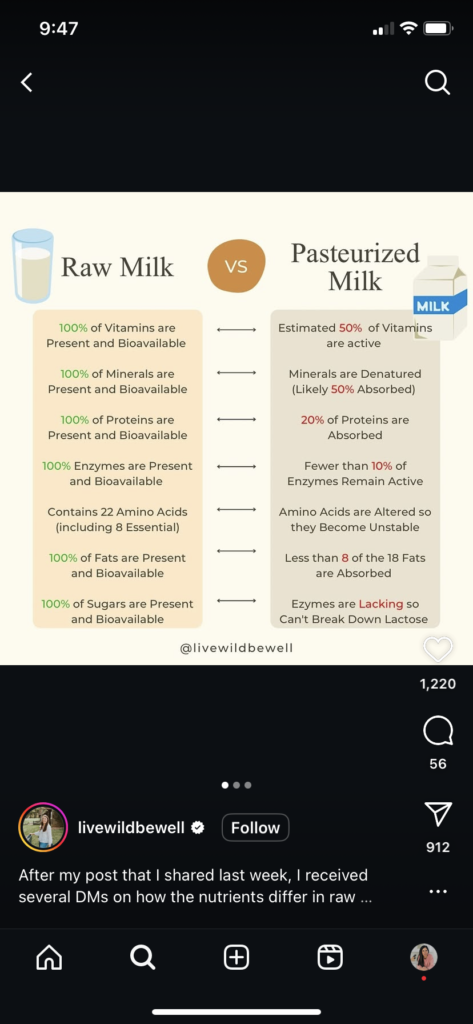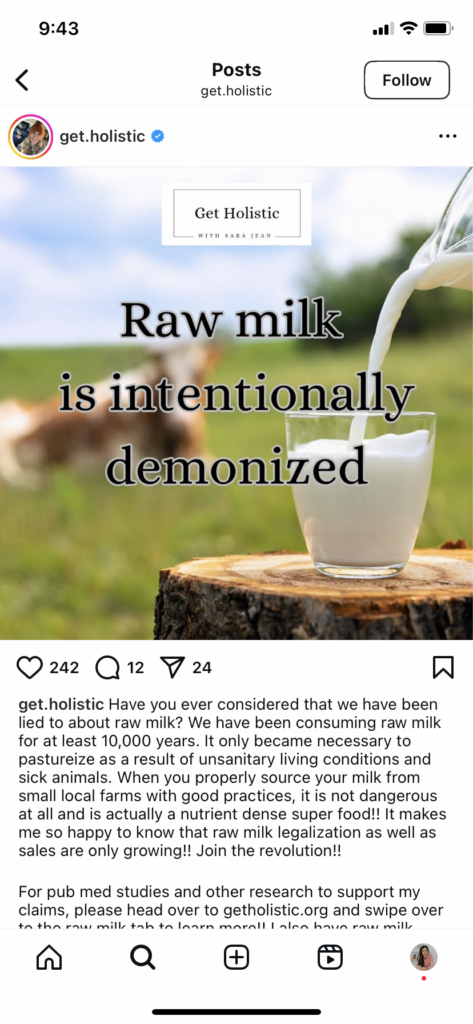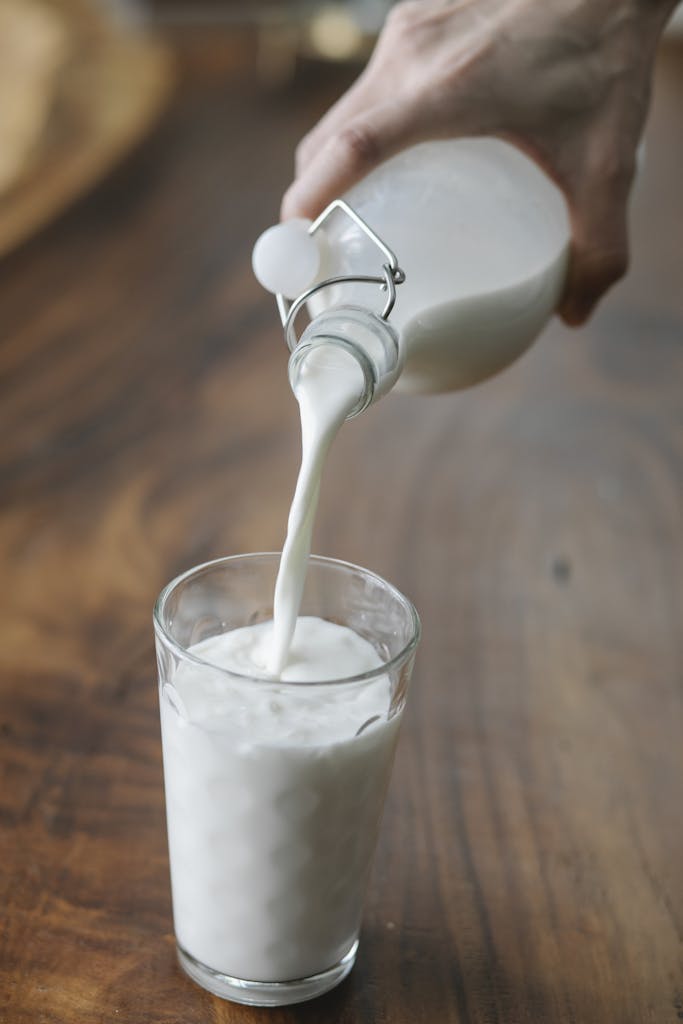The consumption of raw milk—milk that has not undergone pasteurization—has experienced a resurgence in popularity in recent years. Influencers, politicians, and crunchy moms tout its purported health benefits…but is raw milk safe? Are there health benefits to drinking raw milk vs pasteurized milk? Health authorities have warned us for years about the significant risks associated with raw milk consumption, and many areas have even made the sale of raw milk illegal.
This blog post delves into the raw milk trend, explores the reasons behind its growing appeal, examines the claims made by its proponents, and highlights the dangers supported by recent scientific studies.

The Rise of the Raw Milk Trend
Raw milk consumption has transitioned from a niche practice to a broader movement, attracting diverse groups ranging from health enthusiasts to political conservatives. This shift is partly influenced by public figures and wellness influencers who advocate for more natural dietary choices. For instance, Gwyneth Paltrow has expressed her belief that unpasteurized milk may be easier to digest, although she acknowledges that many consider such claims to be pseudoscience. Still, she uses raw cream in her coffee every day, or so she claimed in 2024 on the horribly named ‘Skinny Confidential’ podcast.

Robert F. Kennedy Jr. has advocated for the federal legalization of raw milk, saying it’s the only type of milk he drinks. Trad wives, homesteaders, influencers, and all sorts of anti-conventional science/medicine people have jumped on the bandwagon. This bandwagon always existed, but it’s way out in the open now.
Science is out. Conspiracy theories are in. What a world we live in.
Who is more Likely to Drink Raw Milk and why?
Certain demographics are more inclined to consume raw milk due to their beliefs about health, food purity, and self-sufficiency. These include:
1. Health-Conscious Consumers
Many raw milk drinkers seek out unprocessed and organic foods, believing that raw milk provides higher nutritional value and beneficial bacteria that support digestion and immunity.

2. Holistic and Alternative Medicine Advocates
Individuals who follow holistic health approaches often favor raw milk, viewing it as a remedy for allergies, asthma, and other ailments despite the lack of scientific consensus supporting these claims.
3. Farmers and Homesteaders
Many small-scale farmers and homesteaders consume raw milk from their cows or goats. They argue they can ensure cleanliness and quality control, making pasteurization unnecessary. However, even on the cleanest farms, raw milk can still contain harmful bacteria that pose serious health risks.

4. Libertarians and Food Freedom Advocates
Some raw milk proponents view its consumption as a matter of personal choice and resistance against government food regulations. They argue that individuals should have the right to decide what they consume. This issue with this? Most laypeople can’t interpret science to determine risk.
5. Parents Seeking Natural Nutrition for Their Children
Some parents believe that raw milk is a more natural alternative for their children, providing essential nutrients without the perceived downsides of pasteurization. Interestingly, many of these same parents actively avoid food dyes and other ingredients deemed ‘unnatural’ while overlooking the scientifically proven dangers of raw milk.
6. Conspiracy Theorists and ‘Concerned Moms’
There is also a subset of individuals who reject mainstream food safety recommendations in favor of alternative theories. Many of these individuals refuse to consume artificial food dyes, preservatives, and genetically modified ingredients due to unfounded health concerns, yet paradoxically, they willingly consume raw milk—a product known to harbor dangerous pathogens. This contradiction underscores a broader distrust of regulatory agencies and a preference for anecdotal over scientific evidence.
How Is Milk Pasteurized?
Pasteurization is a process that involves heating milk to a specific temperature for a set period to kill harmful bacteria without significantly altering its nutritional value. The most common methods include:
High-Temperature Short-Time (HTST) Pasteurization: Milk is heated to at least 161°F (72°C) for 15 seconds and then rapidly cooled. This is the most widely used method for commercial milk production.
Ultra-High Temperature (UHT) Pasteurization: Milk is heated to 275°F (135°C) for 2-5 seconds, effectively sterilizing it and allowing it to be shelf-stable without refrigeration until opened.
Low-Temperature Long-Time (LTLT) Pasteurization: Milk is heated to 145°F (63°C) for 30 minutes. This method is often used for small-scale or specialty dairy products.
Pasteurization significantly reduces the risk of foodborne illness while preserving the nutritional content of milk, making it a safer option for consumers.
Is Raw Milk More Nutritious?
Proponents of raw milk consumption assert several health benefits, including:
Enhanced Nutritional Profile: Advocates claim that raw milk contains higher levels of vitamins, minerals, enzymes, and beneficial bacteria compared to pasteurized milk. They argue that pasteurization diminishes these nutrients, reducing milk’s overall health benefits. Raw milk does not contain probiotics, nor does it have significantly more nutrients than pasteurized milk. The vitamins, minerals, and enzymes in milk are heat stable and aren’t significantly diminished by the pasteurization process.
Improved Digestive Health: Some believe that the natural enzymes present in raw milk aid in digestion and may alleviate lactose intolerance symptoms. Raw milk does not contain lactase , which is responsible for breaking down the lactose in milk. There is no mechanism whereby raw milk would be easier for anyone, including people with lactose intolerance, to digest.
Immune System Support: It’s suggested that raw milk’s purported beneficial bacteria can bolster the immune system and reduce the incidence of allergies and asthma. No again.

Is Raw Milk Healthy? The Science:
While these claims have garnered attention, scientific evidence supporting them is limited:
Nutritional Content: Research indicates that pasteurization has minimal impact on milk’s nutritional value. The differences in vitamin and mineral content between raw and pasteurized milk are negligible.
Digestive Health: A randomized controlled pilot study found that raw milk did not reduce lactose malabsorption or intolerance symptoms compared to pasteurized milk. Additionally, the enzymes present in raw milk are likely degraded in the human digestive system, rendering them ineffective in aiding digestion.
Immune Support: While some observational studies have noted an inverse association between raw milk consumption and asthma or allergies, these studies often involve individuals living on farms, making it challenging to isolate raw milk as the protective factor. Moreover, the potential presence of harmful pathogens in raw milk poses significant health risks that outweigh any unproven benefits.
Dangers Associated with Raw Milk Consumption
The consumption of raw milk carries substantial risks due to potential contamination with harmful pathogens. A 2023 review in the Canada Communicable Disease Report revealed that unpasteurized dairy carries with it a risk for illness that is 840 times of pasteurized dairy. Similarly, hospitalizations from raw dairy is 45 times more likely than with pasteurized dairy.
Bacterial Infections: Raw milk can harbor dangerous bacteria such as Salmonella, E. coli, Listeria, and Campylobacter. These pathogens can cause severe illnesses, including gastrointestinal distress, kidney failure, and even death.
Foodborne Illness Outbreaks: Between 2013 and 2018, 75 outbreaks linked to unpasteurized milk resulted in 675 illnesses, with nearly half of the cases occurring among individuals aged 0-19 years.
Antimicrobial Resistance: The presence of antibiotic-resistant pathogens in raw milk poses a growing public health concern, as these pathogens can lead to infections that are difficult to treat.
Recent Concerns – Avian Influenza: In 2024, the highly pathogenic avian influenza A(H5N1) virus was detected in raw milk from infected dairy cattle. This discovery raised alarms about the potential for zoonotic transmission through raw milk consumption.
Raw Milk: Regulatory Stance and Public Health Recommendations
Health authorities, including the U.S. Food and Drug Administration (FDA) and the Centers for Disease Control and Prevention (CDC), strongly advise against the consumption of raw milk due to its associated health risks. The pasteurization process effectively eliminates harmful pathogens without significantly altering the nutritional content of milk, making pasteurized milk a safer choice for consumers.
Raw milk is currently illegal in 20 states. In 30 states, it’s legal with regulations varying from state to state.
In Short: Is Raw Milk Safe?
While the allure of raw milk is rooted in a desire for natural and unprocessed foods, it’s crucial to recognize the substantial health risks it poses. Scientific evidence does not support the purported health benefits claimed by raw milk advocates. Instead, studies consistently highlight the dangers associated with consuming unpasteurized milk. For the sake of public health and safety, PLEASE, PLEASE, PLEASE choose pasteurized dairy products, which offer the nutritional benefits of milk without the accompanying risks of raw milk consumption.

